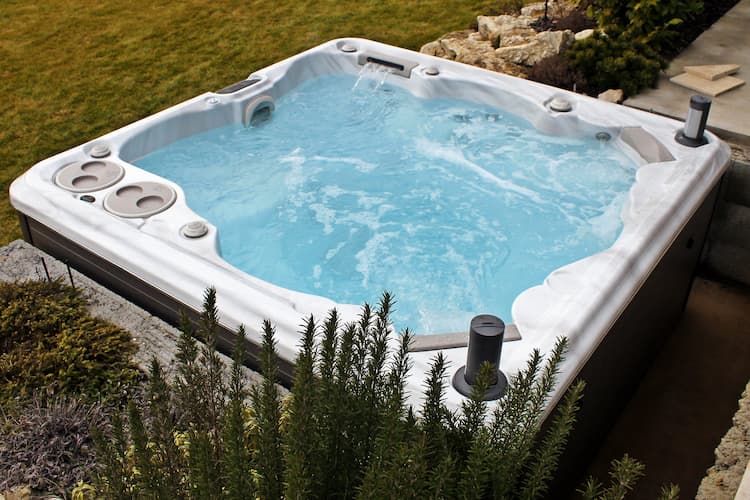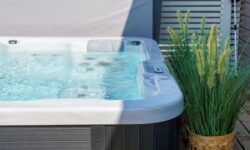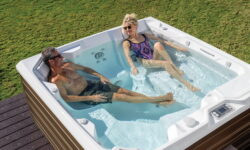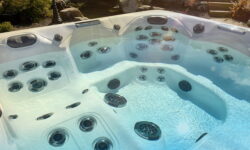Ever wondered how much water you’re splashing around in your hot tub? It’s not a simple answer, as it depends on the size of your tub.
The number of gallons of water a hot tub can hold varies greatly depending on the size of the hot tub. A small hot tub that fits two to three people might hold around 200-300 gallons of water. A larger hot tub that fits six to eight people could hold between 350 to 1000 gallons. Therefore, it’s best to check the specific model of the hot tub for the most accurate measurement.
Whether you’ve got a cozy two-person setup or a party-sized tub, we’ll help you figure out just how many gallons you’re dealing with. Understanding your tub’s water capacity can influence maintenance, cost, and more. So let’s dive in and find out together.

Quick Navigation
Understanding Hot Tub Sizes and Their Water Capacities
You’ve got to understand that the size of a hot tub plays a crucial role in determining its water capacity. This knowledge is crucial for tub maintenance and water conservation. A larger tub will naturally hold more water than a smaller one. However, the shape and depth also impact the water capacity.
Generally, standard hot tubs can hold between 400 to 500 gallons of water. But the range can vary from 250 gallons for smaller tubs to up to 700 gallons for larger ones.
Being aware of your hot tub’s water capacity isn’t just about knowing how much water it can hold. It’s about understanding that maintaining the right water levels is critical for efficient tub operation. Too much water and you risk overflow, which can damage the tub and its surroundings. Too little, and your tub’s components might not function properly, leading to costly repairs down the line.
Furthermore, knowing your tub’s water capacity aids in water conservation. By only filling to the necessary level, you’re not wasting precious water. This is not only good for the environment but also for your wallet. Remember, every drop counts.
Water Volume in Small Hot Tubs: Up to 4 Person
Considering the water volume in smaller hot tubs, you’ll find they typically hold between 250 and 300 gallons, but this can vary based on shape and depth. The tub’s material also impacts the volume of water it can hold. For example, a small acrylic hot tub tends to retain more water than a wooden one due to its non-porous nature.
Compact Spa Maintenance becomes slightly easier with smaller hot tubs. You’re dealing with less water, so the chemical balancing act isn’t as complex. However, it’s important not to neglect regular maintenance. Even with the smaller volume, water quality can deteriorate quickly if not properly managed.
Water Volume in Large Hot Tubs: 6 Person and More
When it comes to large hot tubs, you’re looking at a significant jump in water volume, often holding anywhere from 500 to 700 gallons. These luxurious tubs offer ample space for relaxing, entertaining, or hydrotherapy. However, with this increased size, comes more responsibility for maintenance.

Large hot tub maintenance is essential to keep your hot tub functioning well and prolong its lifespan. Regularly checking and adjusting the water balance, cleaning filters, and changing the water are steps you cannot neglect.
Moreover, large hot tubs have features that enhance your hot tub experience even more. Many large hot tubs come with:
- Integrated sound systems for entertainment
- Advanced hydrotherapy jets for a soothing experience
- Energy-efficient heaters to maintain the desired temperature
- High-grade insulation to minimize heat loss
These features not only boost your relaxation but also add value to your investment. Remember, treating your large hot tub with care and investing in luxury features can turn your backyard into a spa-like retreat. So, consider the water volume, understand the maintenance needs, and enjoy the luxury of your large hot tub to its fullest.
Related Read: How Long Does it Take to Fill a Hot Tub?
Factors Influencing Water Capacity in Hot Tubs
Interestingly, the water capacity in your hot tub isn’t just determined by its size, but also by factors like the number of seats and jets that play a significant role. More seats and jets in the tub result in less space for water. Hence, a larger tub with more seats and jets might hold less water than a smaller one with fewer seats and jets.
The tub material influences the water capacity too. Durable materials like acrylic and fiberglass tend to be less flexible, which might slightly reduce the tub’s inner volume. Conversely, softer materials like vinyl, though less durable, can stretch a bit more, potentially allowing for greater water capacity.
Water conservation strategies are crucial when considering the water capacity of your hot tub. These strategies can include using a cover to reduce evaporation, ensuring the tub is properly insulated, and regularly checking for leaks. By effectively conserving water, you’re not only saving a precious resource but also ensuring that your tub remains at the optimal water level for use.
Practical Tips for Estimating Hot Tub Water Usage
Estimating your hot tub’s water usage involves understanding its capacity, tracking your usage habits, and considering factors like heat loss and evaporation. Getting a grip on this is crucial to maintaining a balance between enjoyable soaking sessions and responsible water usage.
You can take a few practical steps toward efficiently managing your hot tub’s water usage:
- Implement water conservation measures. This means not overfilling your hot tub and covering it when not in use to minimize evaporation.
- Monitor your maintenance frequency. Regular maintenance ensures your hot tub doesn’t lose water through leaks.
- Be mindful of your usage habits. The more you use the hot tub, the more water it will require.
- Consider investing in a hot tub with an eco-mode. This feature can reduce water and heat loss, saving you gallons over time.
Related Read: Is Hot Tub Water Bad for Grass?
Frequently Asked Questions
The cost to fill your hot tub depends on your water source and tub maintenance. On average, it’s typically around $7-$10. However, costs can fluctuate based on local water prices and the size of your tub.
You should change your hot tub’s water every 3-4 months. This ensures optimal water quality and effective sanitation methods. However, it’ll depend on your usage and the effectiveness of your tub’s filtration system.
Yes, efficient tubbing tips include using a cover to reduce evaporation and maintaining proper chemical balance to prolong water life. You can also explore water recycling methods to save more water in your hot tub.
The temperature regulation of your hot tub directly impacts its functionality. Higher temperatures increase heat efficiency but can strain the system. It’s crucial to maintain a balance for optimal performance and longevity of your tub.
Frequent hot tub water changes can impact water conservation negatively. You’re essentially wasting gallons of water. Adopting sustainable practices, like using covers or chemicals to maintain water quality, can reduce this environmental impact.
Conclusion
In essence, the water capacity of hot tubs varies greatly, influenced by size, shape, and seating capacity. Smaller hot tubs might hold around 200-300 gallons, while larger models can contain up to 500-600 gallons. Keep in mind, these factors can affect your water usage and maintenance needs. To ensure proper functioning and longevity of your hot tub, it’s crucial to understand its water capacity and how to manage it.

![How Much Electricity Does a Hot Tub Use? [Per Day, Week, Month] how much electricity does hot tub use](https://hottubtales.com/wp-content/uploads/2023/03/how-much-electricity-does-hot-tub-use.jpg)

![Is Yellow Hot Tub Water Safe? [& Treatment Options] is yellow water in hot tub safe](https://hottubtales.com/wp-content/uploads/2023/10/is-yellow-water-in-hot-tub-safe-250x150.jpg)


